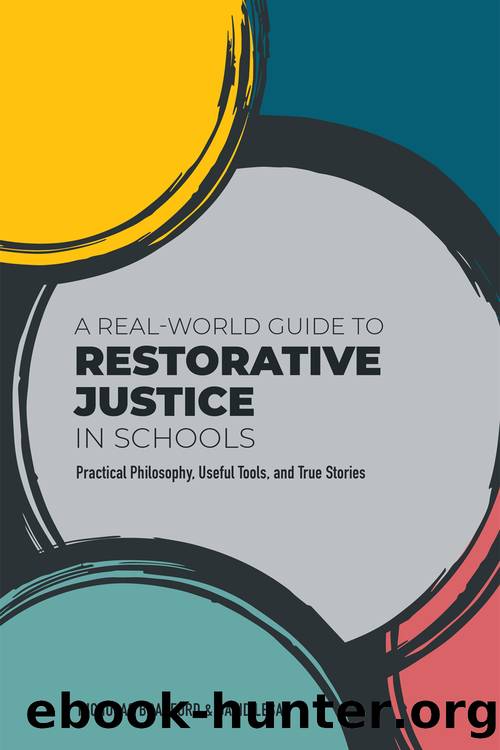Using Restorative Circles in Schools: How to Build Strong Learning Communities and Foster Student Wellbeing by Nina Wroldsen & Berit Follestad

Author:Nina Wroldsen & Berit Follestad [Wroldsen, Nina & Follestad, Berit]
Language: eng
Format: epub
Tags: education, Behavioral Management, Violence & Harassment, Counseling, General, Administration, Social Science, Human Services, Educational Policy & Reform
ISBN: 9781784509170
Google: yC9oDwAAQBAJ
Publisher: Jessica Kingsley Publishers
Published: 2018-10-18T23:29:31.212805+00:00
Implicit bias
Implicit bias means attitudes or stereotypes that affect our understanding, actions, and decisions in an unconscious manner.
In addition to uncovering your own culture, privilege, and experiences, discovering your implicit biases is another great way to âdo your own work.â But, like white privilege, bias is a term that can immediately get a knee-jerk reaction. For instance, you might hear someone say: âIâm not biased. Yes, I am white, but I have dedicated my life to serving students of color and I treat everyone equally.â The key clarification here is that implicit bias is something that occurs unconsciously, unintentionally, and without our control. It is interesting to note that almost every single person carries biases of which they may not be aware, and some biases can be counter-intuitive on the surface. For instance, research at Harvard has shown that the vast majority of us have at least a mild bias towards non-marginalized or privileged societal groups.1 This includes African-American, black, and Hispanic people. This seems mind-boggling until you look at how people of color are widely portrayed in the news, movies, and across pop culture. We have all been shown countless mugshots of black men on television news, for instance, perhaps more than we have been shown images of successful, influential, and happy black men. Our minds have been populated by these representations. So when someone says âthug,â the image that pops into our minds has been crafted by years of people of color being portrayed this way in the news, television and movies. And usually this internal image is different from what we might imagine when we hear âcorporate CEO.â These mental leaps happening without our intention can also influence our day-to-day interactions and expectations of others based solely on how they look or sound, especially if unchecked.
For our RJ courses at the NC4RJ, we use the Project Implicit bias online test from Harvard.2 This asks us to sort and match images and words (both positive and negative), and then to interpret our response times. The idea is that the sorting that goes against our immediate internal bias will take longer to complete. For example, if you are taking a test to determine gender or career bias, you will be asked to sort male and female names and other words that relate to career or family as fast as possible. Many people will discover that they are naturally able to sort male identity with career and female identity with family faster. This would show some bias towards male/career and female/family. There are many categories that you can test, including your response to race, sexuality, age, religion, and disability. It can be troubling to receive the results from these tests, however, especially when we show unconscious bias towards a group that we serve in our career and genuinely care about, or because we have daughters we want to treat fairly, or just because we donât wish to be a biased person. The fact is, we all carry some bias towards those of us who look, think, and act like ourselves.
Download
This site does not store any files on its server. We only index and link to content provided by other sites. Please contact the content providers to delete copyright contents if any and email us, we'll remove relevant links or contents immediately.
Navigation and Map Reading by K Andrew(4895)
Spare by Prince Harry The Duke of Sussex(4806)
Tuesdays with Morrie by Mitch Albom(4414)
Cracking the GRE Premium Edition with 6 Practice Tests, 2015 (Graduate School Test Preparation) by Princeton Review(4053)
Machine Learning at Scale with H2O by Gregory Keys | David Whiting(3668)
What It Really Takes to Get Into Ivy League and Other Highly Selective Colleges by Hughes Chuck(3561)
Never by Ken Follett(3550)
Goodbye Paradise(3463)
Harry Potter and the Prisoner of Azkaban (Book 3) by J. K. Rowling(3125)
Pledged by Alexandra Robbins(3054)
Kick Ass in College: Highest Rated "How to Study in College" Book | 77 Ninja Study Skills Tips and Career Strategies | Motivational for College Students: A Guerrilla Guide to College Success by Fox Gunnar(3003)
Fairy Tale by Stephen King(2976)
A Dictionary of Sociology by Unknown(2865)
Sapiens and Homo Deus by Yuval Noah Harari(2858)
Reminders of Him: A Novel by Colleen Hoover(2781)
The Social Psychology of Inequality by Unknown(2776)
Graduate Admissions Essays, Fourth Edition: Write Your Way into the Graduate School of Your Choice (Graduate Admissions Essays: Write Your Way Into the) by Asher Donald(2744)
Get into Any College by Tanabe Gen Tanabe Kelly(2635)
Zero to Make by David Lang(2634)
